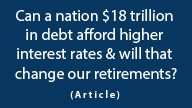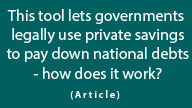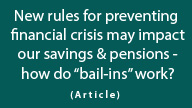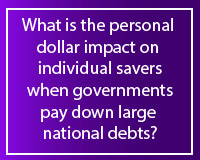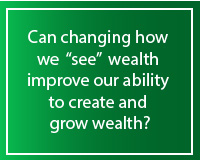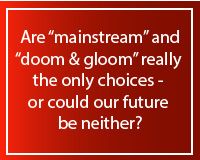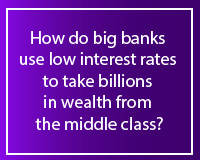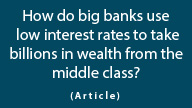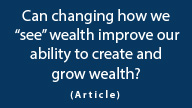Four Conflicts Of Interest Between Governments & Retirement Investors
by Daniel R. Amerman, CFA
Below is the 2nd half of this article, and it begins where the 1st half which is carried on other websites left off. If you would prefer to read (or link) the article in single page form, the private one page version for subscribers can be found here:
"Collateral Damage" & Our Future Financial Security
Now again, to be very clear, I don't think that destroying the foundations of conventional financial planning is at all the goal of the United States government or other nations around the world. Indeed I'm confident they would much prefer that that did not happen. However, when necessary they are willing to allow it to happen, because from their perspective, other goals are demonstrably more important.
A good analogy is that of "collateral damage" during warfare, with civilian casualties sometimes being the unintended consequence of soldiers fighting each other. In most wars nations try to avoid killing civilians, but if bombing or shelling the enemy is how the war is won, then they are willing to take the actions that will predictably lead to those civilian deaths.
What should be taken into account is that in this new place in world history, governments don't have just one temporary motivation for creating this difficult environment for investors. Instead, as reviewed herein and developed in much more detail in the linked resources, there are multiple powerful incentives including:
1) attempted economic growth;
2) attempted job growth;
3) reliably reducing the costs of otherwise impossibly large national debts; and
4) either going on the offensive – or just playing defense – when it comes to economic and currency competitions in our globalized world.
And every one of those has the potential of being a long-term motivation.
Which means that our future financial security and standards of living in retirement could end being "collateral damage" for a long time to come.
Now there are two key aspects to this process of wealth destruction replacing wealth creation. One is political for nations as a whole, and the other is quite personal for us and our financial decisions.
While these policies have been openly implemented on a global basis, there has not been a significant political price in terms of outrage from retirement and other long-term investors – because due to the complexity that is involved, the average investor has no idea what is going on. Oh, they're well aware that their yields from interest payments and dividends are low, but why that is – and what the full consequences are – is a different matter.
Let me suggest that for most people, what we have just covered might be considered as being three separate and even unrelated "dots".
1) Most of us have some degree of understanding of how savings and retirement plans are supposed to work, which is that investing a few dollars today is assumed to reliably create a lot more dollars in the future, given enough time.
2) We are also familiar with inflation, as the dollar has ended the year worth less than it was at the beginning of the year in just about every year of our lives. But while nobody's thrilled with that, the current reported low rates don't seem like a threat to most people.
And 3) terms like "unconventional monetary policies", "quantitative easing" and "negative real interest rates" seem like very dry and obscure topics that relatively few of us even try to understand, because we don't see their relevance to our daily lives.
Let me suggest that those three "dots" are connected, in a manner that serves the interests of governments, even while in combination they could affect every aspect of our future lives, in a very personal and enduring way.
But so long as the average investor and voter remain unaware, then there is no pressure on the governments, and little reason to believe that the situation will change. If enough people do become aware, however – and hopefully this article has helped you in this regard – then the political dynamics could change, with politicians having to take outraged retirees and retirement investors voting them out of office into account, when balancing the various interests and deciding whether the "collateral damage" which reduces standards of living for millions of people – matters.
The second aspect of wealth destruction is on the personal side, and again, the general lack of investor awareness in this area is of critical importance.
Few people realize that the "magic" which traditional retirement investing is based upon can be reversed. Just as they do not realize that we are currently in an environment where as the result of deliberate matter of policy by governments around the world – that reversal has already occurred.
And if we have yields lower than inflation, whether that is from interest rates, or from low dividend yields combined with stock markets falling from current "frothy" heights, then we don't have a mere downward adjustment. Rather, we have a complete reversal where wealth creation becomes wealth destruction. This can change everything that we think we know about investing, as well as every aspect of what we think our future financial security will be.
I believe that there are solutions, and that there are actions we can take to achieve future financial security even in an environment that is destructive to most investors. But they just aren't the usual solutions. To find them, the starting point is education.
 What you have just read is an "eye-opener" about one aspect of the often hidden redistributions of wealth that go on all around us, every day.
What you have just read is an "eye-opener" about one aspect of the often hidden redistributions of wealth that go on all around us, every day.
 A personal retirement "eye-opener" linked here shows how the government's actions to reduce interest payments on the national debt can reduce retirement investment wealth accumulation by 95% over thirty years, and how the government is reducing standards of living for those already retired by almost 50%.
A personal retirement "eye-opener" linked here shows how the government's actions to reduce interest payments on the national debt can reduce retirement investment wealth accumulation by 95% over thirty years, and how the government is reducing standards of living for those already retired by almost 50%.
 An "eye-opener" tutorial of a quite different kind is linked here, and it shows how governments use inflation and the tax code to take wealth from unknowing precious metals investors, so that the higher inflation goes, and the higher precious metals prices climb - the more of the investor's net worth ends up with the government.
An "eye-opener" tutorial of a quite different kind is linked here, and it shows how governments use inflation and the tax code to take wealth from unknowing precious metals investors, so that the higher inflation goes, and the higher precious metals prices climb - the more of the investor's net worth ends up with the government.
 Another "eye-opener" tutorial is linked here, and it shows how governments can use the 1-2 combination of their control over both interest rates and inflation to take wealth from unsuspecting private savers in order to pay down massive public debts.
Another "eye-opener" tutorial is linked here, and it shows how governments can use the 1-2 combination of their control over both interest rates and inflation to take wealth from unsuspecting private savers in order to pay down massive public debts.







If you find these "eye-openers" to be interesting and useful, there is an entire free book of them available here, including many that are only in the book. The advantage to the book is that the tutorials can build on each other, so that in combination we can find ways of defending ourselves, and even learn how to position ourselves to benefit from the hidden redistributions of wealth.


